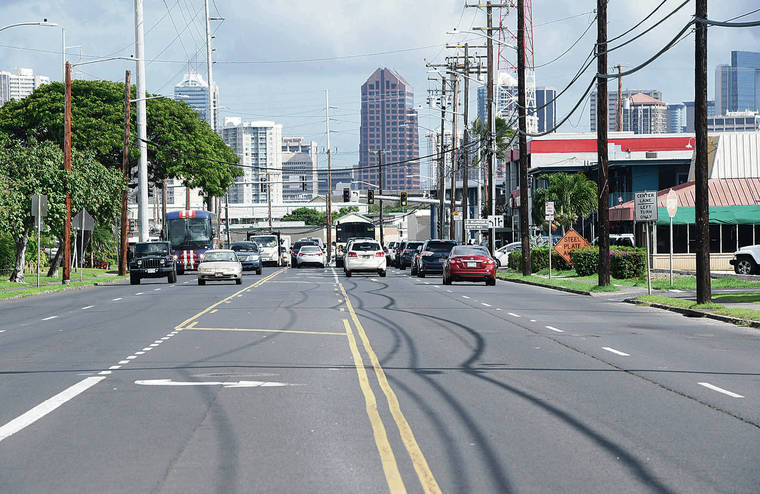The rail project is about to become real to a lot more people. Neighborhoods between Ewa and Aloha Stadium already know well the interruption to business and routines heavy construction can cause.
But in a few months, it’s coming to the congested Dillingham Boulevard corridor when, sometime in the first quarter of next year, the Honolulu Authority for Rapid Transportation will ink its first public-private partnership (“P3”) contract, this one for the construction of the final “City Center” segment of the 20-mile system.
And then work on Dillingham will accelerate, in what HART hopes to be limited to 24 months of disruption, increasing the work to be done in day shifts in order to push through completion of that segment, just under 2 miles long.
This is sure to be harder than anyone expects — and already everyone expects it to be a tough slog. It’s crucial that the larger community become intensely engaged with the particulars of this phase, and HART already has been conducting town-hall meetings.
But the community must be clued in on the financing, too, starting with understanding the particulars of the P3 contract.
That’s why the Honolulu City Council should adopt Resolution 19-256, introduced by Councilwoman Heidi Tsuneyoshi, which aims to ensure this make-or-break contract is executed in full transparency to the public.
The measure is not yet scheduled for a final vote. But when it is: It’s right that the Council should see what the P3 would entail because the city will be paying the partner longterm for rail operations and maintenance.
The partnership was conceived to manage costs of building this final section of the alignment. The partner would work within a set construction budget and recoup revenue through the operations and maintenance agreement into the future.
This surely will affect costs to the city and ultimate fares once the system is in operation, so the taxpayers and transit users need to be informed.
The terms and sign-off on the P3 will be extremely consequential. The D.C. authorities who have oversight already have approved the project’s revised financial plan. But the Federal Transit Administration will not release the remaining half of the $1.55 billion full-funding grant agreement needed to complete the project unless the P3 contract is deemed viable. And as there’s no alternative financing strategy in the HART plan, this one had better work.
Assuming the partner gets the green light for construction, the challenges will be just beginning.
HART is delaying the start of most Dillingham construction until early next year, to allow more time for the traffic plan to be finalized. The work of relocating utilities along the rail route is part of a $400 million contract already awarded to Nan Inc., and agency officials said existing work permits will allow some of that work to begin in January.
HART spokesman Bill Brennan said the plan is to get much of the utility work done along the first 4,000 feet of Dillingham in advance of the P3 contract execution so that both tasks could be carried out simultaneously, on different sections of the road.
That said, once the restrictions are in place for construction of the rail columns and guideway down the middle of the boulevard, that’ll leave only one lane in each direction. Included in a presentation to the community last week are slides showing which businesses are accessible only from Dillingham itself.
There are many. As much as possible, HART must work with the businesses that have alternative approaches to their buildings to optimize them, relieving at least some of the traffic burden on Dillingham, which is sure to be knotted with traffic.
The plan is to maintain turn patterns wherever practical, including left turns. Many of the residents depend on bus routes to get from home to work, and the commitment is to stick to those, too — but it’s likely some restrictions will become necessary.
There simply will be too many cars crawling through those two miles. Businesses are going to need support to survive.
HART has borrowed some ideas from other jurisdictions, including the Los Angeles Metro projects, to mitigate effects. One is its Shop and Dine on the Line (www.shopanddineontheline.com Opens in a new tab), including coupons to area businesses. That portal should be further promoted.
Other ideas that L.A. has applied include helping with road signage to help direct drivers to locations, especially if the shops have opened alternative entrances. There can be off-location promotional fairs and events planned with booths giving merchants an alternate venue for sales.
The businesses themselves are going to have to think out of the box, too, coming up with off-site delivery or merchandise pick-up options, moving some of their sales to phone or online.
In the end, the traffic capacity will be improved in one of Honolulu’s most congested areas. But first stakeholders must pull out all the stops to make the next, long 24 months survivable.

